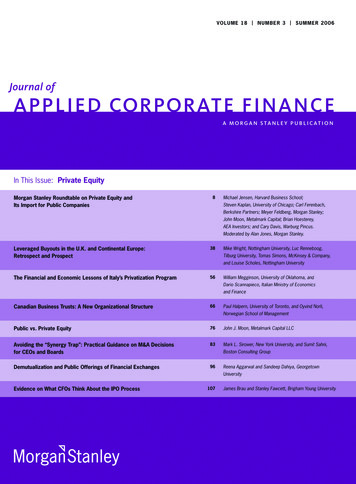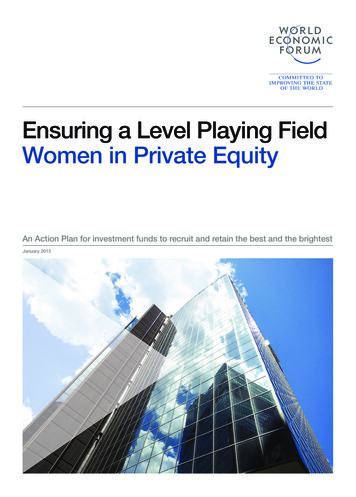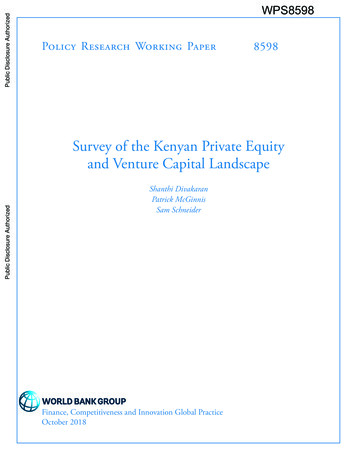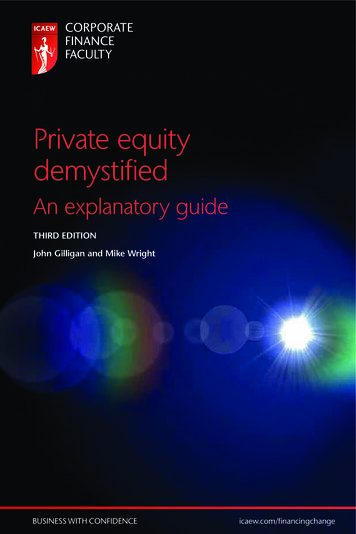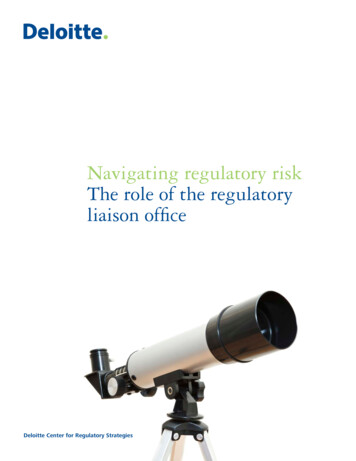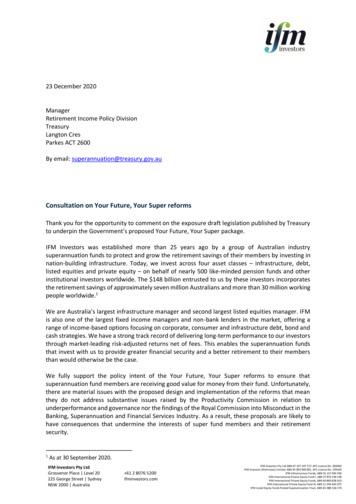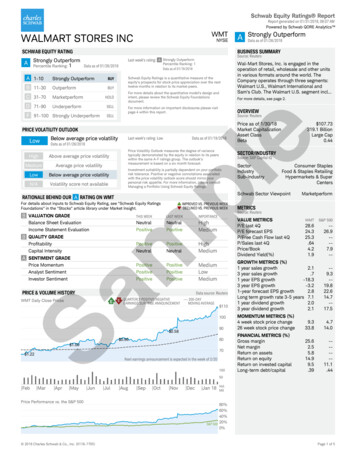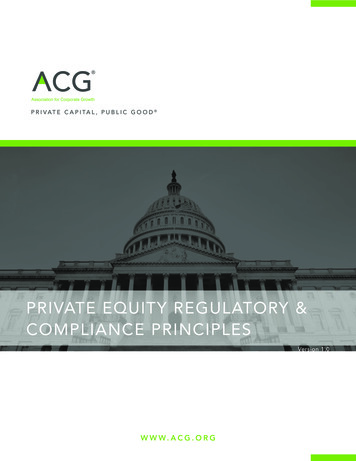
Transcription
P R I V AT E C A P I TA L , P U B L I C G O O D PRIVATE EQUITY REGULATORY &COMPLIANCE PRINCIPLESVersion 1.0W W W. A C G . O R G
PERC PRINCIPLESTable of ContentsA NOTE FROM THE ACG PERT STEERING COMMITTEE.3ABOUT ACG AND PERT.4PERC PRINCIPLES.1. CO-INVESTMENTS.52. CYBERSECURITY.123. FEE & EXPENSES.234. VALUATIONS.33CONTACT INFORMATION.352 2017 Association for Corporate Growth. All Rights Reserved.
A S S O C I AT I O N F O R C O R P O R AT E G R O W T HA NOTE FROM THE ACG PERT STEERING COMMITTEEToday more than ever, private equity professionals of middle-market private equity firms need an informed andconsistent voice to engage both internally, with our firm colleagues, and externally with peers, LPs, regulatorsand policymakers on a variety of issues that impact our funds. Middle market private equity firms are nowconfronted with a dizzying array of compliance requirements and information requests from investors, advisers,and regulators — both domestic and foreign.Complying with the myriad of regulations and navigating the regulatory land mines for registered investmentadvisers is an ever-increasing task. For our relatively small fund families, finance and compliance staffing has notbeen able to grow at a pace commensurate with the regulatory and reporting demands being placed on us andour firms. The increased burden is causing us to engage lawyers and other consultants. As many new rules haveyet to be clarified, these consulting dollars often do not yield clear results.As steering committee members of the ACG Private Equity Regulatory Task Force (PERT) and on behalf of themore than 50 member firms, we are pleased to share with public stakeholders the first iteration of the PrivateEquity Regulatory and Compliance Principles (PERC). The PERC Principles reflect countless hours of surveying,discussion and deliberation among midsize firm practitioners on what are equitable efforts to address growingregulation for the industry.As background, the purpose of the PERC Principles is to develop industry consensus on regulatory andcompliance principles for small and midsize private equity firms. It is our hope that these principles will serve asa resource to many firms and offer PERT and other industry participants a way to engage regulators, legislatorsand other industry groups on the importance of the principles. We as practitioners take on these issues asfiduciaries on behalf of our firms. The principles outlined in this document include:Co-InvestmentsCybersecurityDisclosure of Fees& ExpensesValuationsThrough PERT, middle-market private equity now has the recognized and responsible means to push for meaningfulregulations and to develop uniform, shared best practices. On behalf of the PERT Steering Committee and the 50 members of PERT, we look forward to continued dialogue with our industry partners and stakeholders.Sincerely,Joshua Cherry-SetoBlue Wolf CapitalBlinn CirellaSaw Mill CapitalApril EvansMonitor Clipper PartnersDavid GershmanTrivest PartnersJulianne Lis-MilamHammond, Whitney, Kennedy & Company, Inc.Bèla SchwartzThe Riverside Company3 2017 Association for Corporate Growth. All Rights Reserved.
PERC PRINCIPLESABOUT ACG AND PERTAssociation for Corporate Growth, Inc. (ACG) serves some 90,000 investors, lenders, executives andadvisers to middle-market companies, and counts representation from more than 1,000 private equityfirms in its membership. With a mission of “Driving Middle Market Growth,” ACG is a global organizationwith 58 chapters. Learn more at www.acg.org.ACG “Drives Middle-Market Growth.” Learn how at www.middlemarketgrowth.org.ACG’s Private Equity Regulatory Task Force (PERT) gathers together CFOs, CCOs and in-house legalcounsel of middle-market private equity firms nationwide. Together, they interpret and navigate theoften-complex compliance and regulatory issues affecting the industry.The MISSION of PERT is to serve as the FACE of middle-market private equity in Washington, D.C.: Facilitate communication and coordination among fund professionals; Advocate before federal regulators and legislators on behalf of the private equity industry; Create a network of peers to share best practices; and Educate private equity professionals on regulatory issues that have a direct impact on themand their funds.PERC PRINCIPLES DISCLAIMERThe PERC Principles are provided as statements of suggested practices for regulatory compliance by middlemarket private equity firms. The Principles were developed by experts in the private equity community and informedthrough public comment. Association for Corporate Growth, Inc., (“ACG”), for itself and its chapters, and theirrespective officers, directors, members, employees and agents (collectively, the “ACG Parties”), expressly disclaimsany warranties or guaranties, express or implied, relating to the Principles, and the ACG Parties will not be liablefor damages of any kind, in connection with the material, information or procedures set forth in the Principles orfor reliance thereon by any party. The Principles, including any comments relating thereto, should not be construedas legal or financial advice, and users should seek appropriate accounting, legal or other professional advice toaddress specific facts or circumstances.Copyright in the PERC Principles belongs to ACG, whether or not a copyright notice appears on the materials orany screen displaying the materials.4 2017 Association for Corporate Growth. All Rights Reserved.
CO-INVESTMENTSPERC PRINCIPLESP R I V AT E C A P I TA L , P U B L I C G O O D
PERC PRINCIPLESThe goal of the PERC Co-Investment Principles is to help ensuremore consistent disclosure by private equity firms (“Firms”) toa fund’s limited partners (“LPs”), potential LPs and regulatorsabout a Firm’s co-investment program. It also aims to assist Firmsin developing their co-investment policies and procedures, andprovide a framework for best practices related to a Firm’s overallco-investment program. These co-investment principles areintended to be applicable both where the co-investment is beingmade directly by the co-investor alongside the fund and where itis made through a vehicle controlled by the Firm.GENERAL PRINCIPLES ON CO-INVESTMENTSThese Principles seek to alleviate market confusion and create standardization and parameters forFirm co-investments. At the same time, firms enter into a highly-negotiated Limited PartnershipAgreement (“LPA”) with their investors, which will generally describe the co-investment structure forthat particular fund (“Fund”). Firms may also enter into highly negotiated side letters with investors.While these Principles seek to promote industry standardization, agreements regarding coinvestments may differ from Firm to Firm and/or investor to investor.The Principles assume that the Firm seeks to offer co-investment opportunities to a variety ofconstituents including current LPs, affiliates of the Firm and/or unaffiliated third parties, in a mannerthat is consistent with its fiduciary duties and as provided for in the relevant LPA, offering documents,side letters and regulatory filings.Investors in private equity funds are generally highly sophisticated and understand the potential risksand benefits of co-investments. Terms and provisions relating to co-investments in Fund LPAs andside letters are highly negotiated and reflect the mutually-agreed upon agreement that has beenmade between the Firm and the individual LPs in the funds that it advises.Co-investments frequently move very rapidly. Thus, Firms must balance their obligations oftransparency and fair dealing with their efforts to ensure that the potential transaction is completed,sometimes in a very short time frame.6 2017 Association for Corporate Growth. All Rights Reserved.
A S S O C I AT I O N F O R C O R P O R AT E G R O W T HFirms may employ a broad range of structures and vehicles regarding co-investments. For example,some co-investments may be made through vehicles controlled by the Firm (sometimes with oneor more individual co-investors) while other co-investments may be made directly. There is no one“proper” way to structure co-investments.Each firm, as an investment adviser, owes a fiduciary duty to its private fund clients, and throughoutthe co-investment process a Firm should at all times act in a manner consistent with its fiduciaryduties. This includes being transparent regarding the co-investment process and not making decisionfavorable to the Firm at the expense of the Firm’s clients.A Firm should accurately disclose in the LPA, Private Placement Memorandum (PPM) and other offeringmaterials how it intends to allocate both co-investment opportunities and co-investment expenses, inadvance of the LP signing a Subscription Agreement. This may be achieved by providing potential LPswith the PPM and LPA. Should these allocations change due to negotiations with investors prior to thefinal close, the PPM supplement and LPA should be updated/amended to reflect these changes and beprovided to existing LPs.PRINCIPLES ON FREEDOM OF PARTIES TO CONTRACTAssuming there has been adequate disclosure:»»Firms and investors LPs should be able to negotiate terms as they wish regarding co-investments. This includesterms relating to: whether or not the Firm chooses to offer co-investments at its sole discretion or using a formulaic allocation; allocation of co-investment opportunities to LPs, Firm affiliates, prospective investors and/or other third parties; allocation of expenses for broken co-investment deals; and allocation of costs associated with a co-investment vehicle if one is used (e.g., tax, audit, legal).PRINCIPLES RELATING TO THE DISCLOSURE OFCO-INVESTMENT POLICIESLIMITED PARTNER AGREEMENT DISCLOSUREThe LPA or PPM should provide a clear, accurate description of the Firm’s ability to allocate coinvestment opportunities including, generally:»»To whom co-investments may be offered (i.e., LPs, Firm affiliates, prospective investors and/or other third parties);and7 2017 Association for Corporate Growth. All Rights Reserved.
PERC PRINCIPLES»»The basis upon which the Firm intends to allocate co-investment opportunities (e.g., at the sole discretion of the Firm,based on capital committed to the Fund, etc.).If the Firm offers special rights to individual LPs regarding co-investments in side letters, these specialrights should generally be disclosed;The LPA should provide in clear, unambiguous language:»»How broken deal and other transaction-related expenses and how fee income shall be allocated among the Firm,fund, co-investment vehicles and any direct co-investors;»»How ongoing expenses related to a co-investment vehicle will be shared (e.g., tax, legal, audit); and»»How offsets, if any, will be applied to the co-investment portion of any transaction-related fees or fee income.If the intent is for the Fund to pay 100% of broken deal expenses for deals in which there is coinvestment, this should be clearly and unambiguously stated in the LPA regardless of whether theco-investment is through a vehicle controlled by the GP or direct.In all situations, the allocation must be consistent with the Firm’s LPA, representations made toinvestors, regulatory filings (Form ADV) and its fiduciary duty to its private fund clients.PPM DISCLOSUREShould provide a general but complete summary of the Firm’s co-investment program that makes itpossible for investors to have an adequate understanding of the co-investment program of the Fundso they understand the Firm’s co-investment program prior to investing;Should reflect the practices outlined in the LPA and, if applicable, a term sheet;May provide the Firm with significant flexibility, so long as it is accurately disclosed in the PPM, LPAand regulatory filings, and is consistent with the Firm’s fiduciary duty;All substantive changes to the co-investment policy resulting from Firm/LP/LPA negotiations duringfund raising and incorporated into a revised LPA (including changes resulting from new side letters)should be included in supplemental PPM updates issued at subsequent closings; andAny co-investment arrangement agreed to in a side letter that has a material impact on the coinvestment policy previously presented in the PPM, LPA, regulatory filings or marketing materialsshould be communicated to existing and potential LPs. This may be achieved by, for example,incorporating such changes in the supplemental PPM and/or, if appropriate, amending the coinvestment language in the LPA.8 2017 Association for Corporate Growth. All Rights Reserved.
A S S O C I AT I O N F O R C O R P O R AT E G R O W T HFORM ADV, PART 2 DISCLOSUREA Firm’s Form ADV Part 2 filing should provide a complete description of the Firm’s co-investmentprogram, focusing on the items included in the LPA Disclosure above. The level of disclosure shouldbe discussed with the Firm’s legal counsel.SIDE LETTERSLanguage for offering co-investment in side letters should seek to be broad in scope and non-bindingwith respect to the GP’s obligation to offer co-investment to any particular investor. This may include:»»Language whereby the LP informs the GP that it is interested in seeing all co-investment opportunities.There may be certain co-invest rights given to a particular LP or group of LPs either directlyin the LPA or in an LP side letter that are out of the fund’s MFN provisions. Firms shouldconsider whether disclosure around any MFN carve-out should be included in the LPA, PPMand/or Form ADV.CO-INVESTMENT POLICYFirms should have a reasonably detailed written co-investment policy that explains the basis fordetermining how co-investment opportunities are determined for each deal if not formulaicallycalculated per the LPA.The policy should describe the criteria by which co-investment opportunities are shown to potentialco-investors. The criteria may include, among other things:»»Speed to quickly evaluate and close;»»Sophistication;»»Industry expertise;»»Size of investment; and»»Potential for co-investor to become an LP in future funds.The policy should describe the criteria used to determine the allocation between the Fund andcurrent LPs, affiliates of the Firm and outside parties, taking into consideration the Firm’s fiduciaryresponsibility to the Fund.The Firm should take careful note of potential conflicts that may arise when offering co-investopportunities and seek to mitigate and/or disclose those conflicts, consistent with conflict provisionsof the LPA and any co-investment vehicles.9 2017 Association for Corporate Growth. All Rights Reserved.
PERC PRINCIPLESThe General Partner may provide the Firm’s co-investment policy to a potential investor before or atthe time the subscription agreement is signed. The co-investment policy should be made available toall Limited Partners upon request.CO-INVESTMENT PROCESS AND OPPORTUNITIESTo the extent possible, co-investors should be granted a sufficient length of time to evaluate coinvestment opportunities; however, the amount of time allowed for a specific opportunity willultimately be dictated by the time constraints of the potential deal.»»If a Firm determines it is in the Fund’s best interest to warehouse a portion of an investment for potential or pendingco-investor(s): Co-investors should refer to the language in the LPA regarding reimbursement to the Fund for any costs incurredto warehouse the investment, including, potentially, reimbursement of interest expense if the Fund’s credit linewas used to purchase the investment; If the Fund provided the capital to warehouse the investment, the GP should determine the appropriate charge tothe co-investor to compensate the Fund for the risk involved in warehousing the investment. If there is languagein the LPA regarding this type of compensation, that language must be followed. This may be the Fund’s hurdlerate or a higher risk-adjusted rate; GP’s should consider if there are additional costs that should be charged to compensate the Fund for taking therisk that it may not be able to sell down the investment to co-investors; and Provisions regarding the warehousing of opportunities should be incorporated in the Fund LPA.When follow-on investments are made and Fund/co-investors do not participate on a pro rata basis,unless the GP determines otherwise, the new money should be invested at the current fair marketvalue of the investment. In this scenario, the Firm should determine if there are any conflicts ofinterest especially if different securities are being acquired and determine how to resolve that conflict(often via LPAC approval).EXPENSES RELATING TO CO-INVESTMENTSUnless prohibited by the LPA, a Firm may charge carry or management fees on co-investments.»»Some LPs may insist on language in the LPA that prohibits this practice.»»If a management fee is charged on co-invest, the Firm should consider any implications this would have on sharing offees between the Fund and co-investment (e.g., fee sharing, return of management fees in waterfall, etc.).As a general matter, reimbursement of costs (organization, tax, audit, filing fees, etc.) related10 2017 Association for Corporate Growth. All Rights Reserved.
A S S O C I AT I O N F O R C O R P O R AT E G R O W T Hspecifically to the co-investment entity should be recovered in the following order:1. First, paid by the portfolio company (this approach fairly shares the cost among all investors)2. Second, paid by co-investors; and3. Third, paid by the fundIf all broken deal and co-investment expenses are paid for by the Fund, this should be clearlydisclosed to the LPs in the PPM, LPA, marketing materials and Form ADV, Part 2. In such cases, it isof particular importance that the LPA be absolutely clear that broken deal costs and co-investmentcosts will be charged 100% to the Fund and potential co-investors will not pay any portion of thebroken deal costs.These concepts can be adapted whether or not the co-investment is made through a vehicle ordirectly by the co-investors.REPORTINGREPORTING TO CO-INVESTORSA Firm may provide co-investors with the fair market value of their investment, consistent with thevaluation of the investment by the Fund.If fair market value is not provided, co-investors may be provided with quarterly reporting sufficient tocalculate the fair market value of their investment.Providing co-investors with the portfolio company information from the Fund’s quarterly report may besufficient for most co-investors to meet their internal reporting requirements.Reporting to co-investors should be consistent regardless of whether the co-investment is made througha vehicle or made directly in the portfolio company.PERFORMANCE REPORTINGFund IRR and cash-on-cash performance should never include co-investment returns.A Firm’s overall track record may include co-investment returns, as long as it is clearly disclosed and allco-investments have been included. A Firm’s decision not to include co-investment because of poorperformance or for any other reason may be interpreted as cherry-picking.11 2017 Association for Corporate Growth. All Rights Reserved.
CYBERSECURITYPERC PRINCIPLESP R I V AT E C A P I TA L , P U B L I C G O O D
A S S O C I AT I O N F O R C O R P O R AT E G R O W T HThe goal of these PERC Principles is to help private equity firms(“Firms”) address the rapidly evolving area of cybersecurity in away that takes into account:»» Firms’ responsibilities under applicable federal and stateregulations, including guidance issued by the SEC;»» The fiduciary responsibility Firms owe to their clients, which arethe private funds that they advise; and»» The unique nature of the private equity business model.Because the issue of cybersecurity is relatively new and highly technical, these Principlesare designed to help Firms take appropriate steps to protect themselves from cyberattackthat are in line with the particular nature, business model and risk profile of the Firm. ThesePrinciples do not address international regulations a Firm may be subject to, so Firms areencouraged to work with outside counsel and advisers to determine if they are subject tointernational privacy regulations.The Principles attempt to do this by identifying actions that are: (i) required under federal(Regulation S-P; Regulation S-ID; the Gramm-Leach-Bliley Act) or state laws; (ii) highlyrecommended based upon guidance issued by the SEC; and (iii) recommended basedupon guidance issued by the SEC. If an action is listed under the principles as “HighlyRecommended” or “Recommended” rather than “Required,” it does not indicate that it is“okay” for a Firm to not perform that action.PERC Cybersecurity Principles are not legal advice, and Firms shouldwork closely with outside counsel to review their cybersecurity policiesand implement an appropriate cybersecurity program.13 2017 Association for Corporate Growth. All Rights Reserved.
PERC PRINCIPLESGENERAL PRINCIPLES ON CYBERSECURITYFirms should recognize the increased importance of cybersecurity to their Firm, the funds that theyadvise (“Funds”), the investors in their Funds (“Investors”) and to their Funds’ portfolio companies(“Portfolio Companies”).While there is no one-size-fits-all approach to cybersecurity, Firms should devote adequate time andresources to protect their Firm, Funds and Investors from cybersecurity attack. Firms should alsoconsider their Portfolio Companies in their cybersecurity planning.Firms should work closely with their outside counsel to ensure that they stay abreast of,and in compliance with, regulatory changes not only at the federal level but also at the statelevel. A number of states impose privacy and security requirements that may impact Firms,and therefore Firms (through their outside counsel) should be aware of applicable statelaw requirements. Firms that operate internationally should stay abreast of internationalregulations as well.Firms should be familiar with the guidance that has been provided by the U.S. Securities andExchange Commission (SEC) on the issue of cybersecurity, including the September 2015 Risk Alertissued by the National Exam Program (“2015 SEC Guidance”).Firms should have a comprehensive written policy that describes their cybersecurity policies andprocedures, as referenced in the in the 2015 SEC Guidance. These policies and procedures shouldbe tailored to the Firm’s specific business model and business risks.As part of their policies and procedures, Firms should:»»Include and involve senior management, the Chief Compliance Officer and the Chief Information Officer (if the Firmhas one) in their cybersecurity planning;»»Regularly evaluate cybersecurity risks, and whether their controls and risk assessment processes are both tailored totheir business and sufficient;»»Provide annual cybersecurity awareness training for their employees; and»»Have an incident response procedure in place that is tailored to, and appropriate for, that Firm.Firms should assess their current cybersecurity policies, procedures and systems as they relateto the priorities listed below, which are derived from federal and state regulations and the SEC2015 Guidance.14 2017 Association for Corporate Growth. All Rights Reserved.
A S S O C I AT I O N F O R C O R P O R AT E G R O W T HPRINCIPLES RELATING TO CYBERSECURITYGOVERNANCE AND RISK ASSESSMENTA governance framework is the method to be used to organize and prioritize cyber risks within the Firmand to help develop an organizational structure to manage the overarching security program. As part oftheir cybersecurity and/or privacy and information security policies and procedures, Firms should:REQUIREDAdopt written policies and procedures designed to impose significant safeguards on all personally identifiableinformation (“PII”) and other information protected under federal or state privacy law (e.g. HIPPA);Firms should generally adopt a broad definition of what is considered PII. As discussed below, thereare multiple definitions of PII or other types of protected information, including definitions from NIST1and under the Graham-Leech Bliley Act.2At a minimum, the definition of PII should include:»»»»»»The first name OR first initial and last name of an individual in combination with one or more of the following: social security number; driver’s license number; government identification number; or financial account number, credit or debit card number, in combination with any required security code, accesscode or password that would permit access to an individual’s financial account.In addition, many privacy laws include one or more of the following (among others not listed): personal health information (e.g., health condition, treatment, diagnosis or health care payment data); health insurance information; personal financial information and payment card data (e.g., credit card data, financial account information,financial transaction information, etc.); biometric data (e.g., fingerprint, retina or iris image, or other unique physical representation or digitalrepresentation of biometric data; and username or email address, in combination with a password or security question and answer that would permitaccess to an online account.Other information likely to be found in a subscription document, including wiring instructions.Encrypt PII transmitted wirelessly as certain states mandate the encryption of transmitted PII.Identify or appoint a Chief Information Security Officer, or an equivalent, who will be the individualresponsible for managing the cybersecurity policies, procedures and systems.15 2017 Association for Corporate Growth. All Rights Reserved.
PERC PRINCIPLESRestrict access to records and files containing PII to those who need such information to performtheir job duties.Review the scope of the security measures at least annually or whenever there is a materialchange in business practices that may reasonably implicate the security or integrity of recordscontaining PII.HIGHLY RECOMMENDEDAdopt written policies and procedures designed to:»»Impose appropriate safeguards on all “Confidential Information,” including information other than PII relating to: Investors; Firm employees; Firm vendors, contractors and consultants; Firm business strategies; Accounting and financial information for the Firm, its Funds and affiliates (i.e. manager, investment adviser,investment SPVs, etc.); Portfolio Company information, particularly accounting and financial information; and Deal-related information.Ensure that user controls are appropriate for all of the categories of information referenced above;»»Investigate and consider the encryption of PII and certain high-risk Confidential Information “at rest” on the Firm’sservers (recognizing that encryption of transmitted PII is required). This may include investigating cloud-based andother services that come naturally encrypted;»»Include and involve senior management in cybersecurity planning; and»»Conduct an appropriately-sized annual vulnerability assessment test to identify security holes or vulnerabilities ina computer, network or communications infrastructure. This test can be performed either internally or through athird party.RECOMMENDEDDepending upon Firm resources, conduct an annual penetration test to actively test the effectivenessof the Firm’s cybersecurity program.16 2017 Association for Corporate Growth. All Rights Reserved.
A S S O C I AT I O N F O R C O R P O R AT E G R O W T HPRINCIPLES RELATING TO ACCESS RIGHTS ANDCONTROLSThe SEC has stated that Firms should, at a minimum, implement basic controls to preventunauthorized access to systems or information. Firms will need to demonstrate that a process existsto manage access rights for users across their organization. Firms should:REQUIREDAdopt written policies and procedures designed to:»»Restrict access by unauthorized persons to the Firm network resources and devices;»»Impose appropriate user access restrictions on Firm network and devices (both Firm-issued and personal) by Firmpersonnel, including: adopting a password policy and requiring Firm employees and others with access rights to change theirpassword regularly; and promptly updating or terminating access rights based on personnel or system changes.Actively manage Firm employee access rights, including promptly terminating employee access rightsafter employees leave the Firm.Given the high frequency and increased sophistication of phishing and other attacks, Firms shouldadopt robust policies and procedures related to verification of the authenticity of both internal andexternal requests for Confidential Information, including:»»All requests to transfer funds;»»The release of information relating to Investors or LPs, particularly if that information is PII; and»»All changes to wiring instructions.HIGHLY RECOMMENDEDAdopt written policies and procedures designed to:»»»»Impose appropriate user access restrictions on Firm network and devices (both Firm-issued and personal) by Firmpersonnel, including: establishing employee access rights, taking into account the employee’s role and/or group membership in orderto help ensure that Firm employees and others do not see and have access to data that is not necessary for theperformance of their job; and as necessary, requiring management approval for changes to access rights or control.Promptly restrict access after excessive failed lo
Association for Corporate Growth, Inc. (ACG) serves some 90,000 investors, lenders, executives and advisers to middle-market companies, and counts representation from more than 1,000 private equity firms in its membership.

